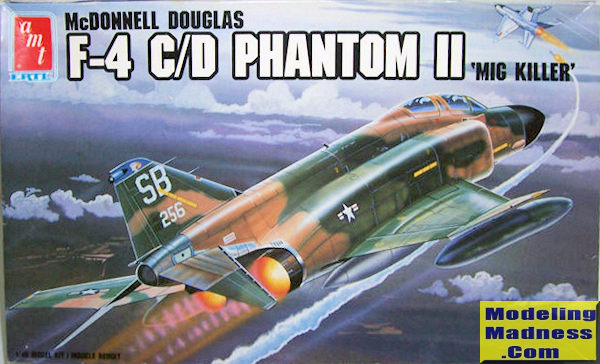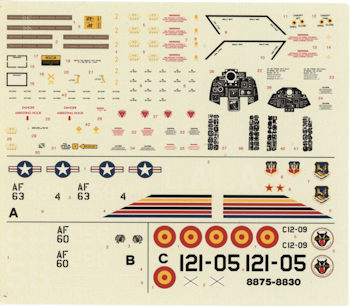
| KIT #: | 8865 |
| PRICE: | I paid $16 for it second hand |
| DECALS: | Three options |
| REVIEWER: | Scott Van Aken |
| NOTES: | Reboxed ESCI kit |

| HISTORY |
Back in the late 1950s, the Secretary of Defense was trying to push a large, complex aircraft onto both the Navy and the Air Force. This was the TFX, a plane designed to meet the requirements of the Navy in terms of a fleet defense fighter and the Air Force in terms of a replacement for the F-105. The program was pretty much a costly mess that did not meet the real requirements of either. It proved to be too big for the Navy, though they did get the Phoenix missle from it which they later used for the Tomcat. The Air Force was never happy with it and the aircraft, since called the F-111, went into protracted development.
What the USAF needed was something NOW. The aircraft chosen was the F-4. Despite being developed for the 'other guys', it was a perfect aircraft for the USAF. It carried a rather large ordnance load, it was fast, and it had missiles for offense. With the addition of USAF avionics, as well as larger, lower pressure tires, the F-4C was developed. An upgraded version with even more weapons capabilities was produced, making it the F-4D. The type served with distinction in Vietnam and was used by ANG and Reserve units into the late 1980s and beyond.
| THE KIT |
In the modeling world, there was no really good 1/48 F-4 until 1979 when Monogram released their F-4C kit. It was a real boon to modelers and was scarfed up about as fast as they could be produced. No modeler of a certain age who likes the plane has not built at least one and it still makes into an excellent model. Not to be outdone, ESCI developed their own 1/48 F-4 the next year (1980). It was designed to be easier to build, though there are some who might argue the case!
The ESCI kit has engraved panel lines, one of the major pluses of the kit. The cockpit is quite basic with very generic looking seats with belt detail, and flat instrument panels and consoles onto which one places decals. It comes with separate windscreen/canopy bits and can be modeled both open or closed.
Typical of most F-4 kits, the intakes have no real trunking and simply stop about two inches back. Wing is a full lower piece with upper halves. Stabs are single pieces and appear to be slotted, which is not correct for a USAF F-4C/D. All of the landing gear doors are molded as a single piece and must be cut for gear down. The landing gear themselves are well done. Unlike the Monogram kit, the flaps and speed brakes are molded in the neutral position. Exhaust is very shallow being only the depth of the short burner cans. The burner cans themselves are the wrong shape. They are more like short F-4E cans than the proper ones with the ridge area normal for F-4C/D. They are also molded in the restricted position rather than the normally open position as seen on the ground.
 For things
under wings you get the usual items. Two wing tanks, a centerline tank, two
pylons for the pair of Sidewinders on each side and four Sparrow missiles. The
Sparrows have a large slot in them for installing the front fins. Speaking of
slots, the pylons and wing tanks attach using large slots that are already
opened in the lower wing. Finally, the radome is only for an F-4C and the first
couple dozen F-4Ds.
For things
under wings you get the usual items. Two wing tanks, a centerline tank, two
pylons for the pair of Sidewinders on each side and four Sparrow missiles. The
Sparrows have a large slot in them for installing the front fins. Speaking of
slots, the pylons and wing tanks attach using large slots that are already
opened in the lower wing. Finally, the radome is only for an F-4C and the first
couple dozen F-4Ds. There is no F-4D seeker included, the kit one being only for the F-4C. Early
F-4Ds were in the 64-xxxx serial range and the kit's F-4D is 66-0256 and so
should have a proper D model seeker.
There is no F-4D seeker included, the kit one being only for the F-4C. Early
F-4Ds were in the 64-xxxx serial range and the kit's F-4D is 66-0256 and so
should have a proper D model seeker.
Instructions are well done with both generic and FS 595 color information. Decals are not ones I'd want to use besides being old. The white is so transparent that the marking disappears against the light tan sheet backing. Markings are for three planes. The box art F-4D, an F-4C of the 58 TTW with large black and white wing and fuselage bands which you have to paint, and an F-4C of the Spanish Air Force. Fortunately, there are no lack of aftermarket markings for this aircraft.
| CONCLUSIONS |
This is a 1990 rebox of the ESCI kit with nothing changed aside from the decals (same markings, though), instructions and box. I have built several of these in the past and found them relatively quick builds, held back by a rather blah cockpit and a gap in the forward lower wing/fuselage join that requires plastic card to fill. I bought this at an on-line auction only because I wanted to try one again. Part of ESCI's trouble regarding this kit is that they tried to do both a Navy and USAF plane using pretty much the same parts. It isn't a bad kit, just not a great one.
November 2016
Copyright ModelingMadness.com. All rights reserved.
If you would like your product reviewed fairly and fairly quickly, please contact the editor or see other details in the Note to Contributors.